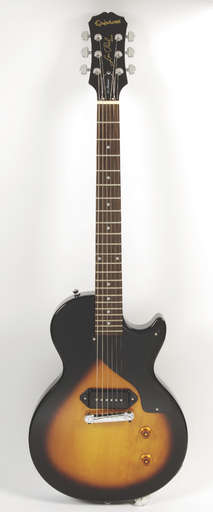MusicRadar Verdict
Believe us, there are not many of you reading this that wouldn't benefit from owning the '57 Les Paul Reissue irrespective of your style.
Pros
- +
A great price. Top tones and solid performance.
Cons
- -
All things considered, genuinely nothing.
MusicRadar's got your back
Once the popularity of the Les Paul reassured Gibson that it was on to something, the company expanded the range both upwards and downwards.
The latter niche was filled by the so-called 'economy' model, the Junior, initially released in 1954. With an original asking price of $99.50, the slab mahogany body, single P-90 pickup and stripped-down spec made it not only Gibson's most cost-effective guitar but highly popular too.
The Junior has seen a recent upsurge in popularity not least thanks to the continuing hugeness of Oakland pop-punkers Green Day and the current availability of the ultra-cool Billie Joe Armstrong signature Junior, and it's the solid performance values and simplicity that maintain the interest.
Epiphone has remained as faithful as practical to the spec of the original early-fifties single-cut Junior - the double-cut version was launched in 1958, by the way - opting for an unbound and very flat slab mahogany body, restrained black scratchplate and classic wraparound bridge.
Originally the pickup would have been one of Gibson's lauded P-90 single-coils that have been the bee's knees since their own introduction in 1946, but here Epiphone USA has designed a P-100 humbucker loaded with classic Alnico magnets for the guitar: it's controlled by single volume and tone pots and is crowned by the always vibesome dog-ear cover.
The coils themselves are, as you'd expect, stacked rather than placed side by side and the single row of screw pole pieces gives nothing away if you like your guitars to look as authentic as possible.
One facet of early Gibson solidbodies is the unusual dimensions of the necks, especially when compared to contemporary 'as thin as Naomi Campbell' options we can all attest to.
Epiphone has dubbed the neck here as 'classic', which translates to a rather wide and very fat feel, and there's no denying that it's a hefty construction.
That's not to say that it's in any way uncomfortable: it's really not and with a set-up offering a slightly higher action than usual, this is a man's guitar!
Although the Junior comes out of the box strung with a regular 10 set, it does scream out for a heavier gauge simply because the guitar demands you absolutely thrash it and, what's more, seems perfectly able to stand up to any level of abuse. We'll see…
Sounds
Although P-90s are traditional single coils in the electronic sense, their fatter and wider bobbins do give a higher output and vamped-up mid-range than Fender-style singles.
There's plenty of bite on offer too, and the fact that the P-100 here has stacked coils means the traditional single-coil hum and abrasive top end is replaced by a rounder, more tuneful tone albeit with the same high output that can be dialled in as required.
Cleanly we found that using the tone pot to smooth off the trebly corners still further allowed for a nice soupy tone akin to that of a Tele's neck pickup on steroids, while adding increasing amounts of gain took the Junior from blues and punk into classic rock territory with ease.
Things do turn nasty at high gains, but if you have the gumption the guitar has the tone and we could easily visualise using this guitar in whatever scenario we found ourselves.
For slide, though, it's just the thing with aggressive Thorogood-style licks befitting richly from the spec, and, at this price, anyone with the slightest interest in playing or learning slide should snap one up.
It'd make a more than adequate second guitar too… So, can it handle itself in a fight? We set it up with a set of humungous D'Addario .13s and we can safely say we cramped up long before it did…
Simon Bradley is a guitar and especially rock guitar expert who worked for Guitarist magazine and has in the past contributed to world-leading music and guitar titles like MusicRadar (obviously), Guitarist, Guitar World and Louder. What he doesn't know about Brian May's playing and, especially, the Red Special, isn't worth knowing.
“A synthesizer that is both easy to use and fun to play whilst maintaining a decent degree of programming depth and flexibility”: PWM Mantis review
“I feel like that song had everything we needed to come back with”: Bring Me The Horizon’s Lee Malia on Shadow Moses, its riff and the secrets behind its tone, and why it was the right anthem at the right time
“I said, ‘Are we sure we can write a song about death?’”: The story of Mike + The Mechanics' classic No.1 The Living Years










